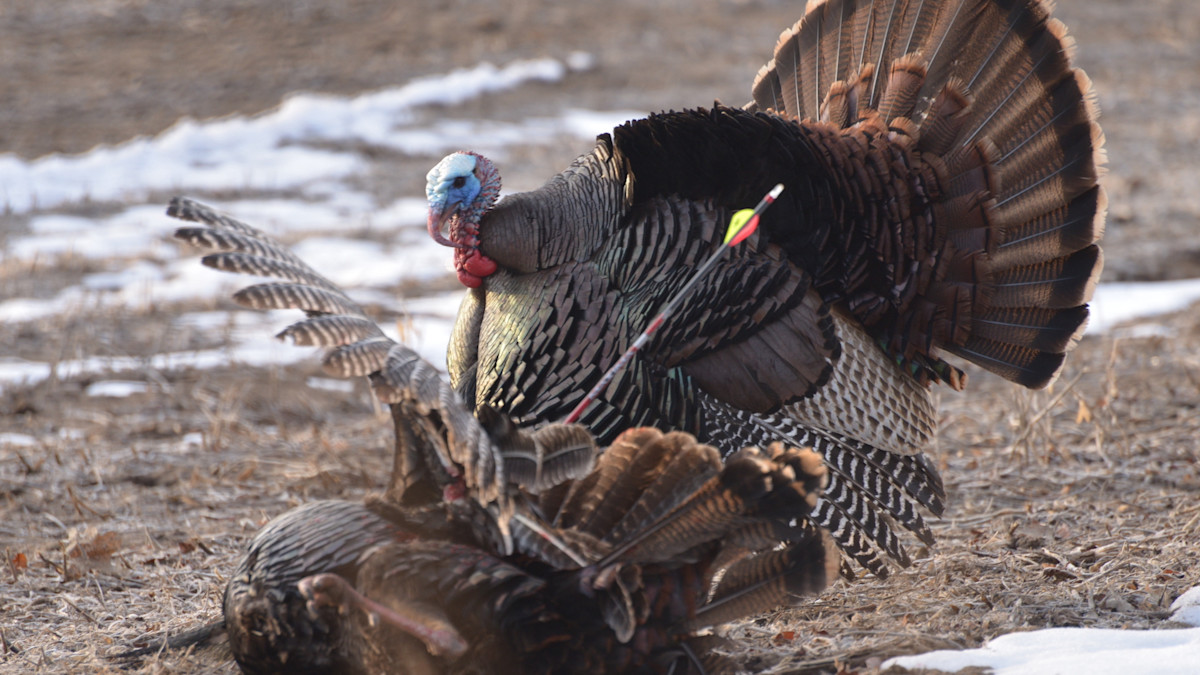
It’s not uncommon to hear turkey hunters say, “Gobblers are meant to be shot in the face with a load of 5s.” The general sentiment there is that if you’re going to turkey hunt, a 12 gauge is a hell of a lot better of a choice than a bow.
The truth is, that depends on what you want to get out of a hunt. If running and gunning is your thing and you’re not patient, then you have your answer. If you want to learn how to really call in birds, what decoy setups are most deadly, and gain a deeper understanding of turkey behavior, then bowhunting them is a good choice.
Even if it really sucks, sometimes.
Calling Realities
I grew up hunting turkeys with a shotgun, and then I spent about a decade hunting only with archery tackle. Now I do both, and I can say this with confidence—if you want to really learn how to call turkeys, bowhunting them is the best way. When you aren’t mobile, and you’re confined to a blind, you have to talk the birds into your spread. A forty-yard drive-by just won’t cut it.
What I learned was that I didn’t need to persuade a gobbler to give me a look, I needed him to believe he needed to mix it up with my decoys. This means you usually can’t get by with a few yelps and then nothing. You need to learn how to speak fluent turkey. Toms need to hear the right chatter, and just as often, so do the hens.
When the birds do come in close, you get a crash course on all of the subtle vocalizations and body language they use to communicate. When the hunt ends with a bird crossing the 40-yard mark, that doesn’t happen. During a turkey bowhunt, that’s just when things really start to get interesting and you enter the no-mistake zone. Close proximity birds teach you a lot, and they just don’t happen as frequently when hunting with a shotgun.
Decoy Doubts
While it would be easy to argue that the advent of hub-style blinds made bowhunting turkeys a common endeavor, the rise of ultra-realistic decoys made it fun. I’ll never forget learning this lesson after sitting in a blind on public land in Nebraska years ago during a magical, early April morning.
I called in a dozen jakes and toms by lunchtime, and every single one of them flared at my decoys. I could have filled up the bed of a truck with dead birds if I had a shotgun, but I didn’t kill a single one with my bow. When I got home from that trip, I ordered some Dave Smith Decoys and my world changed.
Not-so-realistic decoys will work, especially if you only need a bird to close within shotgun range. I like my turkeys at about seven yards when I bowhunt, so a shotgun distance is five or six times too far. When you witness real birds interact with a flock of realistic fakes, you realize how important that can be to an overall turkey hunting plan—no matter what your weapon of choice is.
If you want to arrow a bird, it’s a necessity. But shotgun hunters who spend time working pressured birds could learn a lot from sitting in a blind watching how live toms and hens react to realistic decoys. They’d also learn what decoys work best throughout the season. There’s a time for a whole flock topped off with a full strutter, and there are times when a single feeding hen is the ticket. Hours and hours in a bow blind watching real birds react to fakes can teach you a lot about decoy choice and timing.
Longbeard Patterns
Maybe a dozen years or so ago, I had four jakes fly down into a field I was bowhunting. They didn’t commit, and I didn’t think much of it. Later, when the farmer came out to work the field, I gathered up my gear and moved to a different blind. A few hours into that sit, I watched the same four jakes cross through and head back to where they were in the morning.
They were more than a mile from where I saw them earlier, and the next day I happened to watch them walk pretty much the same route. It made me realize how vulnerable birds can be if you get onto their patterns. One way to do this is to sit in a blind with a bow for a full day.
Now, dark-to-dark turkey sits can be torture, but you sure learn a lot about all-day activity. My time bowhunting turkeys has made me scout so much harder for all of my hunts, so I can find locations where I should be able to count on activity at specific times throughout the day. This helps my own hunts a lot but has also been crucial for putting my daughters on longbeards.
I know the prospect of bowhunting turkeys doesn’t appeal to everyone, but the truth is, it’ll make you a better turkey hunter. Plus, when you do have a strutter in the decoys at point-blank range and you settle your pin just below his wing butt, it’s a pretty sweet feeling.
If you want to read more about developing your turkey hunting skills, check out: 3 Underrated Turkey Decoy Setups, 3 Calling Mistakes Every Turkey Hunter Makes, and 3 Turkey Timing Mistakes All Hunters Make.





Conversation